What have we been up to? (Achievements to date)
✓ Completed project proposal
– thus gaining clearer understanding of project goals
✓ Conducted first round of observations (completed October 6th)
✓ Preliminary data analyzed
✓ Gained experience interacting with the community
✓ Had 2nd meeting with our community partners (met October 12th)
– collected decals to be put up and discussed our findings thus far
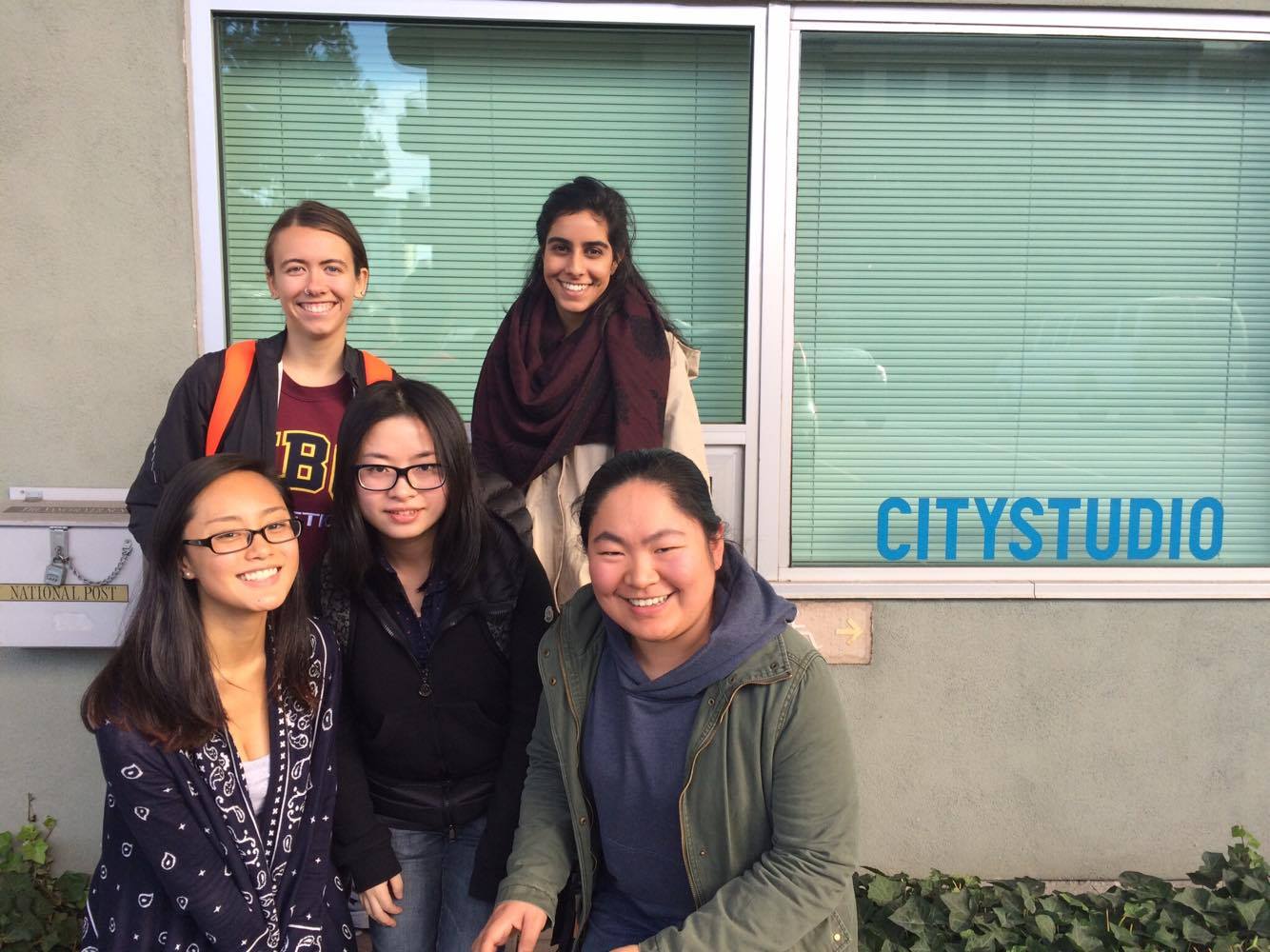
All smiles after a successful second meeting with our community partners at City Studio.
Here’s our to-do list for the week: (Objectives for week of October 12th)
- Make any possible improvements to our observation and interview process.
- Fill in consent form with project details for interviews prior to second round of observations (will likely take place on week of Oct 17-21).
- Continue to learn more about the local/global impact of our community project!
What?
This term is flying by! As mentioned above, we have had many achievements to date but we would like to reflect on one in particular. On October 6th, we conducted our initial observations and interviews at Roundhouse Community Centre. Although we had been anticipating this day for awhile, we truly didn’t know what to expect and found ourselves both excited and anxious as 12pm approached. For one hour, our role was to observe community members sort their waste and record specific data on what we saw, all the while remaining inconspicuous. The task seemed simple enough but once the flood of Elsie Roy students arrived, we had to develop creative techniques to watch the waste sorters closely without raising suspicion. Thankfully, it was a team effort so when one of us didn’t have the best viewing angle, the other was able to compensate. After our observations were completed, we conducted informal interviews with four randomly selected community members. Feeling accomplished, we left Roundhouse with our first set of data to analyze.
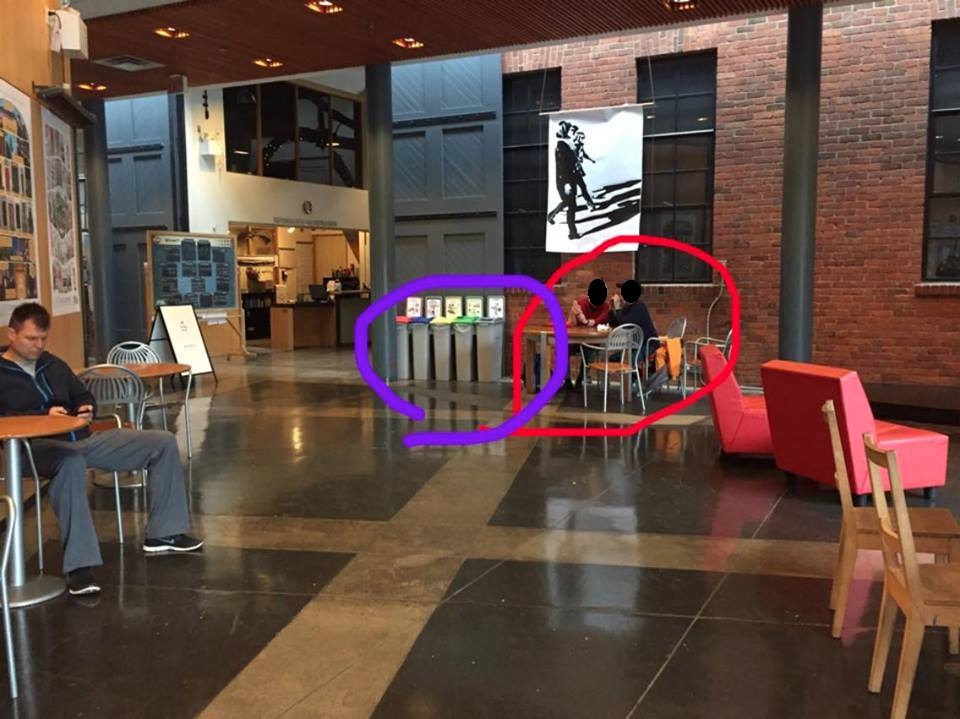
The purple marks the bins we observed and the red marks where we sat.
Our moment of significance came after we were able to look over the data. To our surprise, children had a high average percent correctness (~81%) when it came to sorting their waste. Although our results are from just one brief observation, the irony is worth noting because one of the characteristics of the new decals is that they are level with children’s height and are catered towards them. Maybe our results were just a coincidence or maybe children are more knowledgeable when it comes to waste sorting than expected. We hope that these speculations can be answered by the time all observations are done and all data is analyzed. It will be interesting to see the results of the next observation.
So what?
Our initial findings revealed that Roundhouse Community Centre members, most notably children, are already doing a wonderful job at sorting their waste. The new decals will be successful if they can build off of the community strengths and help with waste diversion even more. We feel hopeful of what our positive findings may indicate for the future. If younger generations are showing an interest in sustainability, we are going in the right direction. Passion to sustain our environment doesn’t stop in four years when the city’s 2020 Action Plan is complete. The initiatives need to be adopted by younger people who will be the ones to carry them forward. In the words of Ron Finley, “the funny thing about sustainability is that you have to sustain it” (TEDTalks, 2013). Finley also noted that children are capable of much more than what society tends to give them credit for, especially once they have broken out of their “predetermined path” built upon youth of the past (TEDTalks, 2013). The children at Roundhouse Community Centre are a possible testament to this notion, which is perhaps an uplifting reflection of our modern day education system, where students are being taught how to sort waste in school, or our modern day use of media, where children are being exposed to topics of environmental/waste consciousness. The younger generation is also exposed to zero waste stations early in life, which may make their adaptability and transition into waste diversion easier.
As for the older generation, we interviewed four adults who reported using the zero waste stations at some point and they all appreciated the addition of the stations and found them helpful. However, the percentage of correctly sorted waste by adults was not perfect (~81% as well) so we know there is room for improvement. This is reassuring, because the addition of new decals on the bins could make a difference. A thought we had regarding why some adults may not sort their waste correctly, aligns with an idea presented by Bradley and Herrera (2015), where the duo claims the “‘healthy self” is sustained through the creation of “unhealthy others’”. Maybe those who sorted their waste only partially correct felt that was good enough because other individuals don’t sort their waste at all. On the other hand, the adults who incorrectly sorted their waste may just not know how, so hopefully the new decals can help. We want to bring it back to the community’s strength though and mention that the majority of adults did sort their waste correctly!
Now what?
Despite the first impression we were given after our time in the community, we need to remain open-minded and understand that a different day may bring about different results. Perhaps the implementation of the decals will affect a different portion of the population than who they were originally designed to target. Either way, we hope that the decals will show potential to improve waste diversion – but we will have to wait and see!
Objectives For The Coming Weeks
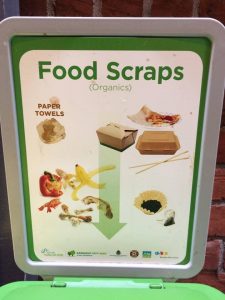
Current food scraps signage.
- Conduct our second observation and more interviews on October 20th
- We’ll be using the same data collection tables to keep things consistent. However, we will try to conduct our informal interviews with individuals we witness using the
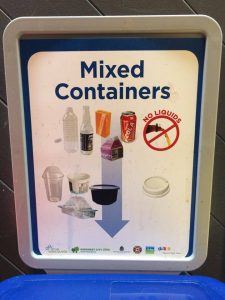
Current mixed containers signage.
waste stations because we feel their opinions may be valuable.
- We’ll be using the same data collection tables to keep things consistent. However, we will try to conduct our informal interviews with individuals we witness using the
- Conduct the third and final observation and interviews two weeks after second observation.
- Analyze all data (statistically and qualitatively) and conclude with thoughts/suggestions for improvements that target the group of people struggling the most with waste sorting using ideas provided by community members.
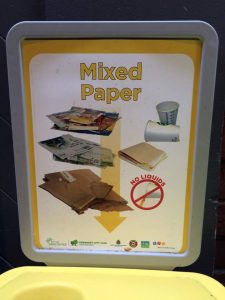
Current mixed paper signage.
- Make deeper connections between our community project and the concept of food justice throughout the next few weeks as we gather more insight and work on our individual academic review papers.
- Stay connected with our community partners through e-mail and this blog.
- Collaborate with the other zero waste station group to make a poster for our final presentation and the event at City Hall.
We are excited to finally be out in the community and experiencing our proposed project coming to life. The future observations will be even more intriguing than the first as we will be adding new decals and finding out if community member’s waste sorting is effected in any way.
References
Bradley, K., & Herrera, H. (2016). Decolonizing food justice: Naming, resisting, and
researching colonizing forces in the movement: Decolonizing food justice. Antipode,
48(1), 97-114.
TED Talks. (2013, March 6). Ron Finley: A Guerilla Gardener in South Central LA. Retrieved
from https://www.youtube.com/watch?v=EzZzZ_qpZ4w